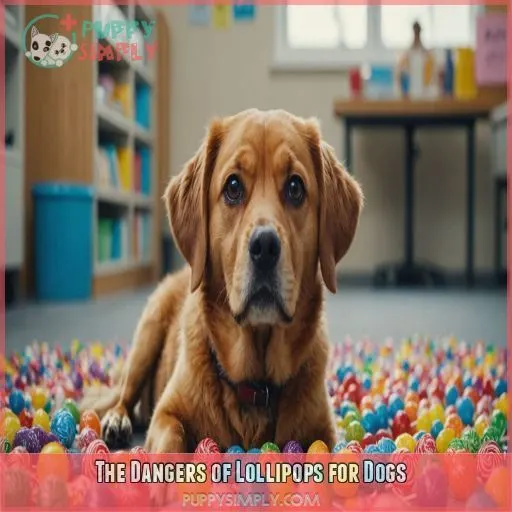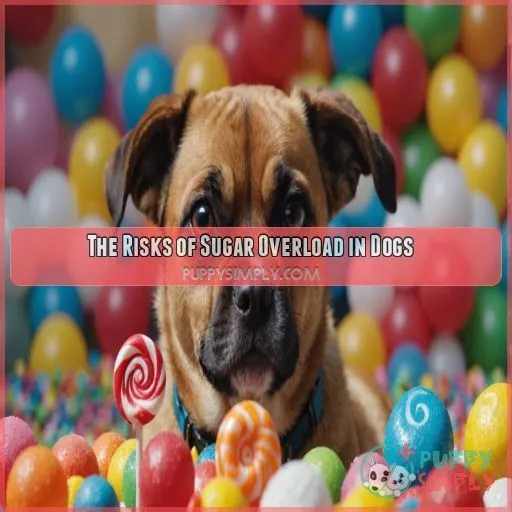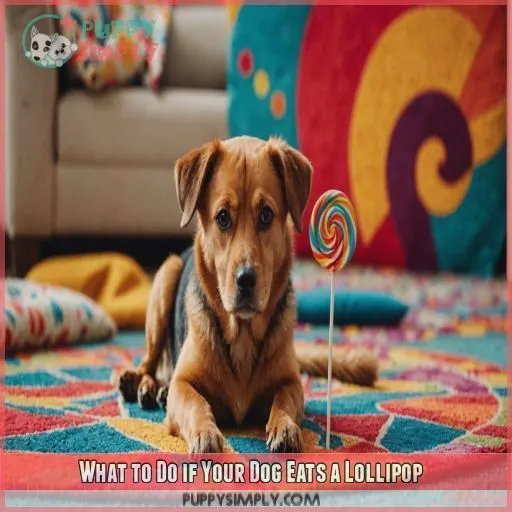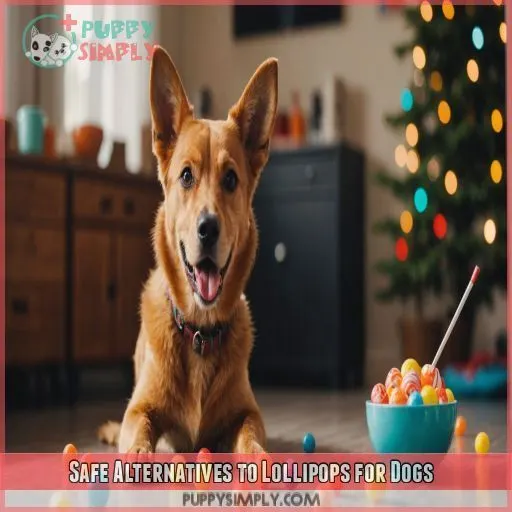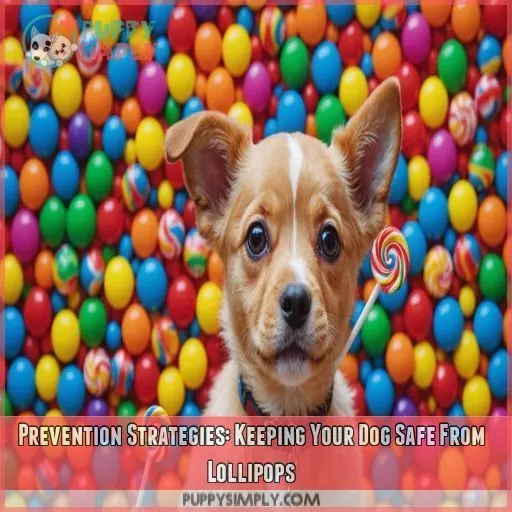This site is supported by our readers. We may earn a commission, at no cost to you, if you purchase through links.
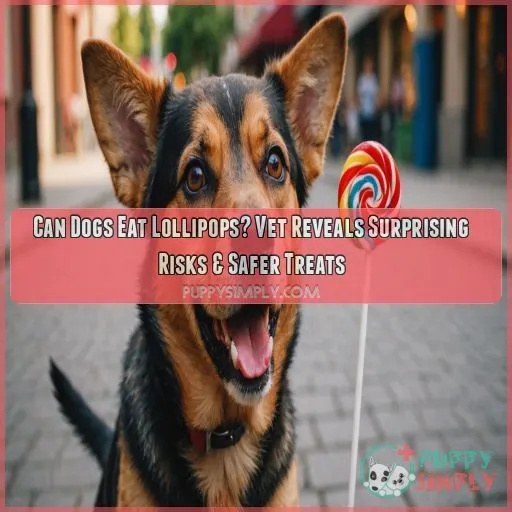 You definitely don’t want your dog eating lollipops!
You definitely don’t want your dog eating lollipops!
Those sugary sweets are a recipe for disaster for our canine companions.
Lollipops pose a serious choking hazard, can cause nasty digestive issues, and some even contain xylitol – a deadly toxin for dogs.
Plus, all that sugar isn’t doing your pup any favors, putting them at risk of obesity, dental problems, and other health woes.
Trust me, it’s not worth the risk.
Stick to dog-friendly treats that are low in sugar and formulated with their well-being in mind.
Your vet can point you to some tasty, tail-wagging options.
Table Of Contents
- Key Takeaways
- The Dangers of Lollipops for Dogs
- The Risks of Sugar Overload in Dogs
- What to Do if Your Dog Eats a Lollipop
- Safe Alternatives to Lollipops for Dogs
- Prevention Strategies: Keeping Your Dog Safe From Lollipops
- Online Expert Services for Pet Owners
- Frequently Asked Questions (FAQs)
- What happens if my dog eats lollipops?
- What do I do if my dog eats lollies?
- What candy can dogs eat?
- Can my dog eat a dum dum?
- Are all lollipop flavors equally dangerous for dogs?
- Can my dog become addicted to eating lollipops?
- How long do the effects of a lollipop last in dogs?
- Can I give my dog a small piece of my lollipop?
- What happens if my dog licks a dropped lollipop?
- Conclusion
Key Takeaways
- Lollipops are a major no-no for dogs – they’re a serious choking hazard and can cause digestive issues and even poisoning from toxic sweeteners like xylitol.
- Too much sugar from lollipops can lead to dental problems, obesity, and worsen conditions like diabetes and heart disease in your pup.
- If your dog does snag a lollipop, call your vet right away – they’ll guide you on the next steps to keep your furry friend safe and healthy.
- Instead of risky lollipops, treat your dog to vet-approved, dog-friendly snacks that are low in sugar and made with their well-being in mind.
The Dangers of Lollipops for Dogs
Before you let your pup near that sweet lollipop, you should know that these sugary treats can spell trouble for your four-legged friend. From gastrointestinal issues to choking hazards, lollipops are a definite no-no for dogs. Let’s explore the surprising risks and discover safer alternatives to keep your canine companion happy and healthy.
Gastrointestinal Issues
Lollipops are basically doggy kryptonite for their sensitive stomachs. The high sugar content can wreak havoc, causing vomiting, diarrhea, and general tummy troubles. It’s like a doggy digestive rollercoaster – one they’d rather skip! Keep those sugary treats far away to avoid an upset canine belly.
Choking Hazard
Lollipops can pose a serious choking hazard for dogs. Those hard, round candies on a stick are simply not meant for canine consumption. The stick itself could get lodged in your pup’s throat, while the hard candy could become a dangerous obstruction. Keep these sugary treats far away – your dog’s safety is too important to risk.
Toxic Sweeteners
In addition to the choking hazard, lollipops often contain artificial sweeteners like xylitol that are highly toxic to dogs. Even small amounts can cause a dangerous drop in blood sugar, seizures, and liver damage. Steer clear of lollipops and other candies – your pup’s health is far sweeter without them!
- Xylitol is an artificial sweetener found in many candies that’s extremely poisonous to dogs.
- Ingesting xylitol can cause a dangerous drop in blood sugar, seizures, and liver damage.
- Many other artificial sweeteners like sorbitol are also unsafe for canine consumption.
- Dogs lack the enzymes to properly digest refined sugars, which can lead to digestive upset.
- Stick to dog-safe treats that are low in sugar and made with healthy ingredients.
The Risks of Sugar Overload in Dogs
Excessive sugar intake can wreak havoc on your dog’s health, leading to dental issues and compounding problems for pups with pre-existing conditions. It’s really important to be mindful of your furry friend’s sugar intake to keep them happy and healthy.
Dental Issues
Sugar can also wreak havoc on your dog’s pearly whites. Just like humans, too much sugar leads to cavities and gum disease in our canine companions. Think of it this way – would you let your kids go to town on a bag of lollipops every day? Probably not! The same goes for our furry friends.
| Dental Issue | Impact |
|---|---|
| Cavities | Painful, can lead to tooth loss |
| Gum Disease | Inflammation, bleeding, bad breath |
| Tartar Buildup | Bacteria, tooth decay |
The good news is that regular teeth brushing and dental treats can help keep your dog’s mouth healthy. Talk to your vet about the best dental care routine for your pup. A little prevention goes a long way!
Susceptibility for Dogs With Preexisting Conditions
If your pup has pre-existing health issues like diabetes, heart disease, or joint problems, they’re even more susceptible to the negative effects of sugar overload.
Those extra licks of a lollipop could wreak havoc on their delicate systems.
Keep a close eye on your furry friend – even small amounts of sugar can cause big trouble.
Obesity is another major risk factor, so make sure your pup stays trim and healthy.
When in doubt, err on the side of caution and keep all sugary treats far out of reach.
Your vet can give you personalized guidance on your pet’s dietary needs.
What to Do if Your Dog Eats a Lollipop
Oh dear, your pup got into the lollipops again, didn’t they? Don’t panic – here’s what to do. First, keep a close eye for any signs of illness like vomiting or diarrhea. Then, give your vet a call right away to get their expert advice on the best next steps.
Monitoring for Signs of Illness
If your dog gobbles down a lollipop, keep a close eye out for any concerning symptoms like vomiting, diarrhea, or lethargy. Changes in appetite, energy levels, and overall behavior are also signs something might be amiss. Don’t hesitate to contact your vet – they’ll help you determine if your pup needs medical attention.
Contacting Your Veterinarian
If you suspect your dog has eaten a lollipop, don’t hesitate – call your vet right away. They can provide expert guidance on the next steps to take, whether it’s a routine appointment or an emergency visit. Their quick action could be the difference between a happy, healthy pup and a trip to the ER.
| Action | Urgency |
|---|---|
| Call Vet | Immediately |
| Schedule Appointment | Within 24 Hours |
| Contact Pet Poison Helpline | Immediately |
| Observe for Symptoms | Next 24 Hours |
Potential Veterinary Interventions
If your pup polished off a lollipop, call the vet right away. They may recommend inducing vomiting or providing supportive care like fluid therapy and dietary changes to prevent complications. Don’t delay – getting your dog prompt medical attention could be the difference between a happy, healthy hound and a trip to the emergency vet.
Safe Alternatives to Lollipops for Dogs
Luckily, there are plenty of safe and healthy alternatives to lollipops that your pup can enjoy. From dog-specific treats to homemade goodies, your veterinarian can provide personalized recommendations to keep your canine companion happy and healthy.
Dog-Specific Treats
Opt for dog-specific treats formulated with safe, digestible ingredients. Look for low-sugar, low-fat options at your local pet store or boutique. Avoid anything with artificial sweeteners, as they can be toxic to your furry friend. Consult your vet for personalized treat recommendations that fit your dog’s unique needs and health.
Homemade Healthy Treats
Homemade healthy treats make a budget-friendly, allergy-friendly alternative to lollipops. Whip up delicious dog biscuits with wholesome ingredients like peanut butter, bananas, or carrots. Bake a batch of sugar-free dog treats for a sweet treat that’s safe for your pup. As a responsible dog owner, prioritize your furry friend’s health and safety first.
Consulting Your Veterinarian
Consult your vet, they’re the experts when it comes to your pup’s health and nutrition. They can recommend safe, yummy treats that are perfect for your dog’s needs. Plus, regular checkups help catch any issues early. Your vet’s got your back, so don’t be shy about asking for advice on keeping your canine companion happy and healthy.
Prevention Strategies: Keeping Your Dog Safe From Lollipops
Keeping your dog safe from lollipops and other sugary treats is really important. Secure these temptations, train your canine, and educate kids – a little prevention goes a long way in protecting your furry friend’s health.
Securing Lollipops and Other Sweets
Keep lollipops and sweets safely stored away, out of your pup’s reach. Invest in pet-proof containers or place them on high shelves. Establish firm kitchen rules – no sneaking treats! Opt for dog-approved snacks instead, like carrot sticks or freeze-dried bites. That way, you can rest easy knowing your furry friend is safe from sugary hazards.
Training Your Dog
Train your dog with basic commands like "leave it" and "drop it" to prevent them from nabbing lollipops. Leash training, potty training, and crate training can also help keep your pup safe. And don’t forget socialization – it helps dogs learn what’s appropriate to chew on and what’s not!
Educating Children
It’s super important to teach kids about the dangers of sharing human treats like lollipops with pets. Teach them simple rules: "No people food for Fido!" and "Ask Mom or Dad before giving Rover a snack." By sharing this responsibility, you’ll keep your furry friend safe and teach kids to be responsible pet owners.
| Teaching Strategies | Benefits |
|---|---|
| Set Clear Rules | Establishes boundaries |
| Lead by Example | Demonstrates responsible behavior |
| Make it Fun | Engages children’s interest |
| Involve Kids | Fosters ownership and care |
| Praise Good Behavior | Reinforces the right actions |
Online Expert Services for Pet Owners
Struggling to get answers about your pet’s health? Online expert services connect you with verified professionals who can provide personalized advice whenever you need it, no office visit required. From pet-related legal queries to troubleshooting home remedies, these digital resources make getting the guidance you need as easy as a few clicks.
What Are Online Expert Services?
Online expert services connect you with verified professionals who can answer your questions about your pet’s health anytime, anywhere. With experts in fields like veterinary medicine, you can get the guidance you need without leaving home, often at a lower cost than traditional visits.
- Convenience
- Accessibility
- Affordability
Why Are Online Expert Services Popular?
People are turning to online expert services more than ever for their convenience, accessibility, and affordability. With a growing need for quick answers on legal, health, and tech issues, these virtual experts provide trustworthy guidance from the comfort of your home. It’s like having a team of pet-loving pros at your fingertips!
Using Online Expert Services Responsibly
Using online expert services responsibly means recognizing their limitations. While convenient, they’re no substitute for professional care in emergencies. Stick to general advice, and consult qualified vets for personalized treatment. Weigh the costs and benefits – sometimes an in-person visit is worth the investment for your pet’s wellbeing. When in doubt, get a second opinion from your trusted vet.
Frequently Asked Questions (FAQs)
What happens if my dog eats lollipops?
Uh oh, did Fido get into the candy jar? If your pup munched on a lollipop, keep an eye out for tummy troubles. Those sugary sweets can give dogs a real sugar rush – and not in a good way! Better call the vet just to be safe.
What do I do if my dog eats lollies?
If Fido gets into the lollipops, don’t panic – just keep a close eye on him. Call the vet right away if he shows signs of illness like vomiting or lethargy. They’ll know just what to do to get him back to his happy, healthy self.
What candy can dogs eat?
Paws down, dogs should steer clear of sugary lollipops! Opt for pawsome pet treats made with wholesome ingredients – your pup will be wagging their tail with delight. Ruff it up with safe chews, not sweet nothings!
Can my dog eat a dum dum?
No way, pup! Those dum dums are a no-go. The sugar and artificial sweeteners can really upset your tummy. Let’s stick to tasty, dog-friendly treats that won’t leave you feeling ruff. Your vet can recommend some paw-fect options.
Are all lollipop flavors equally dangerous for dogs?
Lollipops are a recipe for doggie disaster, no matter the flavor. While some may seem harmless, they’re a one-way ticket to a tummy ache. Steer clear, and stick to dog-approved treats to keep your pup happy and healthy.
Can my dog become addicted to eating lollipops?
No, your pup won’t become a lollipop addict – dogs don’t have the same sweet tooth as humans. But let’s keep those sugary treats far away to avoid tummy troubles and unwanted weight gain. A healthy snack‘s a much sweeter deal for your furry friend!
How long do the effects of a lollipop last in dogs?
The effects of a lollipop in your pup can linger for up to 24 hours. Keep an eye out for tummy troubles and call the vet if symptoms persist. Heed that sugar rush!
Can I give my dog a small piece of my lollipop?
Dangling that lollipop in front of Fido is like waving a red flag – it’s simply begging for trouble! Pups and sweets don’t mix, so keep those sugary treats safely out of your dog’s reach. Your vet will thank you for it.
What happens if my dog licks a dropped lollipop?
Oh no, if your pup licks a dropped lollipop, it could make them feel yucky. Those sugary sweets can upset their tummy. Best keep those lollies far away from your furry friend!
Conclusion
Lollipops are definitely a no-go for your furry friends.
They’re a real danger for dogs, with choking hazards and toxic sweeteners being the main culprits.
Instead of risking your pup’s health, stick with vet-approved, dog-friendly treats that are tailored to their dietary needs.
You’ll keep your pup happy and healthy by choosing safe alternatives.
Can dogs eat lollipops? Absolutely not, the answer is a resounding no.

